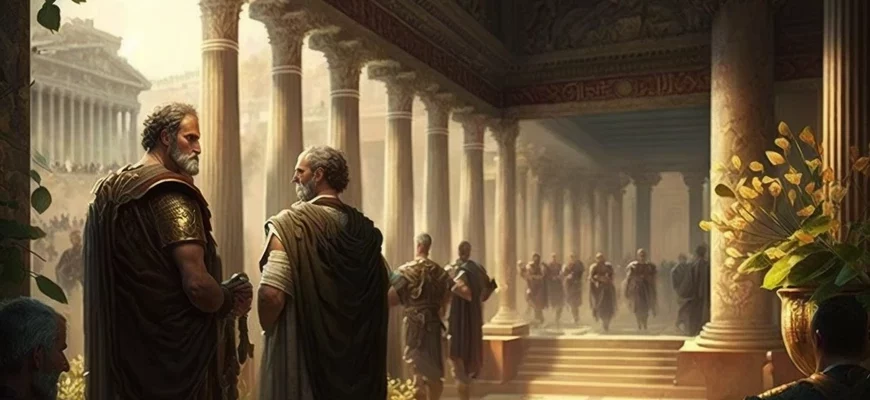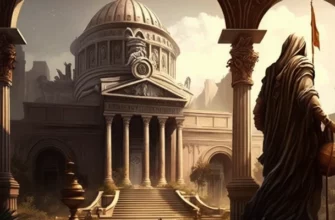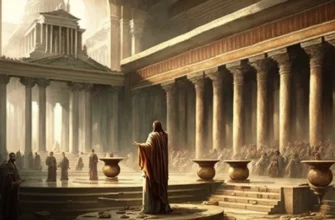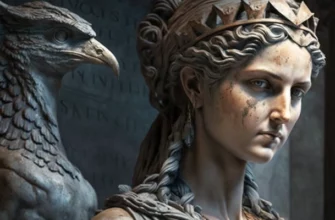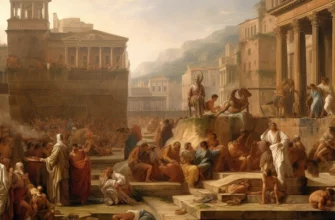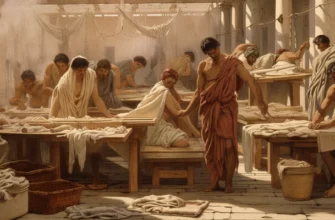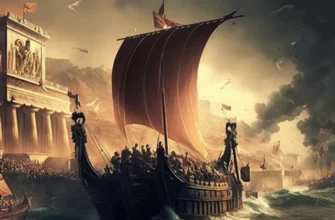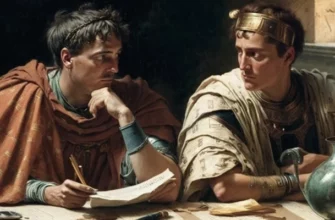The Roman government and society consisted of a political system, legislation, social hierarchy, and cultural traditions. Rome had a republican form of government with two consuls, which was later replaced by an imperial monarchy. Laws were established by the Senate and the People’s Assembly, and justice was administered by praetors. Roman society was divided into five classes based on wealth, as well as patricians and plebeians. Roman culture included religion, art, architecture, and everyday traditions. The influence of the Roman Empire is still felt today in the modern world in law, politics, and culture.
- The political system of Rome
- Legislation and justice
- Social hierarchy
- Roman culture and traditions
- Religion
- Art and Architecture
- Daily life and traditions
- Roman Society
- Family and Marriage
- Education and science
- Economy and trade
- Countries of the Roman Empire
- Agriculture and crafts
- Military affairs and conquests
- The modern influence of the Roman Empire
- Conclusion
The political system of Rome
Ancient Rome had a republican form of government with two consuls who were elected annually by the popular assembly. Important decisions were made by the Senate, which consisted of patricians (wealthy aristocrats) and independent members elected according to specific criteria. The popular assembly consisted of patricians and plebeians (the lower social class) and had limited powers. Laws were established by the senate and the popular assembly, and justice was administered by praetors. In the 1st century BC, the republic was replaced by an imperial monarchy with the emperor’s absolute power.
Legislation and justice
Legislation in ancient Rome was based on a system of civil law and the Law of the Twelve Tables. Laws were enacted by the Senate and the People’s Assembly. There were various courts in Rome, including praetorian courts, which administered justice in public and private matters. In addition, Rome had an appeals system that allowed decisions of higher courts to be challenged. Roman law had a significant influence on the development of law in Western Europe and the United States.
Social hierarchy
Ancient Rome was divided into social classes based on wealth. The five classes included patricians (wealthy aristocrats), equites (middle class entrepreneurs), plebeians (lower class), clients (who depended on patrons), and slaves. Patricians and equites had significant political and social influence, while plebeians and slaves were deprived of many rights. The influence of plebeians on politics increased after the creation of the popular assembly in the 5th century BC, but social inequality remained.
Roman culture and traditions
Ancient Rome was known for its luxurious architecture, art, literature, and theater. Roman buildings such as the Colosseum, the Forum, and the Pantheon are renowned for their beauty and grandeur. Roman literature included famous writers such as Virgil, Ovid, and Seneca. Roman theater was known for its comedies and tragedies, which often reflected Roman culture and mythology. Roman cuisine included ingredients such as olives, wine, cheese, and honey, and their lifestyle was reflected in traditions such as thermal waters and public baths.
Religion
Ancient Rome had a multifaceted religious system that included numerous deities and religious rituals. The main gods of Roman religion were Jupiter, Juno, and Mars, but there were also many lesser-known deities. The Romans believed in signs from the heavens and performed religious rituals to ensure favorable divine influence on their lives. Roman priests had a significant influence on society and politics and were responsible for performing religious rituals and communicating with the deities. In some cases, the Romans believed in emperors as deities. At the end of the 4th century, the Roman emperor Constantine converted to Christianity, leading to the gradual abandonment of the ancient Roman religion.
Art and Architecture
Art and architecture were important parts of ancient Rome. Roman architecture was known for its large structures, such as the Colosseum, the Pantheon, and the Forum Romanum. Buildings were made of stone, and arches and domes were designed to support weight and create a grand impression. Roman art included mosaics, statues, and frescoes, which often decorated churches and buildings. Drama, theater, and literature were also important components of ancient Roman art, reflecting Roman culture and mythology. Many of the influential artists of the time were of Greek origin, and Greek motifs and techniques were skillfully combined with Roman traditions to create unique works of art.
Daily life and traditions
The daily life and traditions of ancient Rome had a profound influence on Roman society and culture. Romans lived in houses that were organized around a courtyard and usually had their own slave to help with household chores. Romans were known for their thermae, or baths, which were used for hygiene and health. They also loved to eat well and were known for their lavish banquets and dinners. Roman women dressed in lace and silk, while Roman men were known for their togas and sandals. The Romans also enjoyed entertainment such as ball games, fights, and competitions in athletic games. All of these domestic traditions reflected the Roman way of life and values.
Roman Society
Ancient Roman society was hierarchical, with people divided into different social classes. The highest class was the patricians, who were the richest and most influential people in Rome. The plebeians, who were artisans, merchants, and farmers, were less influential but made up the majority of Rome’s population. Officials such as quaestors and praetors also had influence in Roman society. Slavery was also common in Rome, and slaves performed hard labor in the city and on farms. All of these social classes had different rights and responsibilities, which affected their opportunities in life. Roman society was also a military state, and many people served in the Roman army as a way to raise their social status.
Family and Marriage
Family and marriage were very important in ancient Rome. The Romans believed that the family was the foundation of society and were devoted to their families. Marriage was an important social ritual that ensured the birth of offspring and maintained social ties between families. Marriages between different social classes were restricted, and most marriages were within the same social class.
In ancient Rome, it was customary for the husband to be the head of the family and have complete authority over his wife and children. Women did not have the right to vote, own property, or hold official positions. However, in some cases, women could have a significant influence on family and political affairs through their connections with influential men.
In ancient Rome, divorce and remarriage were permitted, but divorce was a complicated process that required certain legal procedures. Laws were also passed to regulate inheritance and property succession, which affected family relationships.
Education and science
Education and science were important in ancient Rome. Many Romans were educated at home, but there were also private and public schools where the basics of grammar, rhetoric, and mathematics were taught. Education was mainly available only to children from wealthy families, as it required financial expenditure on books and teachers.
Ancient Rome saw significant achievements in science, particularly in engineering, medicine, and law. Roman engineers designed and built vast road networks, aqueducts, and water pipes, as well as bridges and amphitheaters. Roman doctors were quite productive, using a variety of treatment methods, as well as anesthesia and surgical instruments.
Law in ancient Rome developed significantly and formed the basis of many modern legal systems. Roman law was written in laws that regulated various aspects of life, including family law, civil law, and criminal law. The laws were written in such a way as to ensure justice and equality before the law for all citizens, regardless of their social status.
Economy and trade
Economy and trade were important aspects of life in ancient Rome. The Romans possessed vast territories and rich resources, which contributed to the development of agriculture and crafts. In particular, they grew grain, oil, grapes, and smelted metal.
Trade played an important role in the Roman economy. Roman merchants traded with various parts of Europe and the Mediterranean, as well as with Persia and India. With the help of a vast network of roads and waterways, the Romans carried out a large number of trade transactions. Overall, the economy and trade of ancient Rome were important factors that helped ensure the development of Roman civilization and its influence on other countries.
Countries of the Roman Empire
The Roman Empire covered a significant part of Europe, Asia, and Africa. The Roman Empire included countries that had varying degrees of influence on the empire. The most important countries of the Roman Empire were:
Italy – the homeland of the Romans, where the main cities of the Roman Empire were located.
Greece – the cultural center of the ancient world, which had a significant influence on Roman culture and art.
Egypt – an important province of the Roman Empire, which provided a significant amount of grain for the empire.
Gaul – the lands of modern France and Belgium, which were conquered by the Romans during the Gallic Wars.
Spain – a country with significant ore resources, which were used for the production of weapons and other metal products.
North Africa – the lands on the southern coast of the Mediterranean Sea, which were an important region for growing grain and oil.
Syria – an important province that supplied the Roman Empire with grain and other products.
Britain – conquered by Rome in the 1st century AD, it was an important region for metal mining and wool trade.
This is not a complete list of the countries of the Roman Empire, but these countries played an important role in the development of the empire and had a significant impact on its culture, economy, and politics.
Agriculture and crafts
In ancient Rome, agriculture and crafts played an important role in the life of society. The main means of livelihood for most of the population were farming and cattle breeding. Crafts were also well developed in the Roman Empire: the production of metal products, glass, textiles, pottery, and other goods. Craftsmen organized themselves into guilds and united into workshops. This organization of work ensured high quality products and standardized production. Many crafts were passed down from father to son, which allowed for the preservation of experience and traditions of production.
Military affairs and conquests
Military affairs were one of the most important areas of activity in ancient Rome. The Roman army was well-organized and disciplined, equipped with powerful weapons and technology. Thanks to its military strength, the Roman Empire became one of the largest and most powerful states of its time. Rome conquered new territories and maintained its possessions through military force. In addition, Roman military capabilities were also used to guard and protect cities and roads in the empire. The Roman Empire developed military art and strategy, as well as the use of engineering structures to conquer enemy positions.
The modern influence of the Roman Empire
The Roman Empire has left a significant mark on the modern world. Roman culture, art, and architecture have influenced the development of Western culture. Many Roman innovations, such as roads, bridges, the legal system, and language, remain important components of the modern world. Many of the basic principles of Roman politics and law have been adopted and applied in various countries around the world. In addition, the Roman Empire contributed to the spread of Christianity, which has become the most widespread religion in the world. All these factors make the Roman Empire an integral part of world history and culture.
Conclusion
Ancient Rome was one of the largest and most influential states in the world. Its political system, legislation, culture, and military power left a huge mark on world history. The Roman Empire was a developed civilization with a high level of culture and science, and its influence can be seen to this day. Despite its achievements, the Roman Empire experienced its decline, but its legacy remains an integral part of world history and culture.
Buildings were made of stone, and arches and domes were designed to support weight and create a majestic impression. Roman art included mosaics, statues, and frescoes, which often adorned churches and buildings. Drama, theater, and literature were also important components of ancient Roman art, reflecting Roman culture and mythology. Many of the influential artists of the time were of Greek origin, and Greek motifs and techniques were skillfully combined with Roman traditions to create unique works of art.
